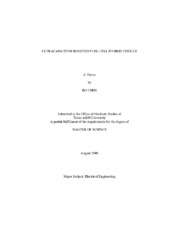| dc.description.abstract | With the escalating number of vehicles on the road, great concerns are drawn to
the large amount of fossil fuels they use and the detrimental environmental impacts from
their emissions. A lot of research and development have been conducted to explore the
alternative energy sources. The fuel cell has been widely considered as one of the most
promising solutions in automobile applications due to its high energy density, zero
emissions and sustainable fuels it employs. However, the cost and low power density of
the fuel cell are the major obstacles for its commercialization.
This thesis designs a novel converter topology and proposes the control method
applied in the Fuel Cell Hybrid Vehicles (FCHVs) to minimize the fuel cell's cost and
optimize the system's efficiency. Unlike the previous work, the converters presented in
the thesis greatly reduce the costs of hardware and energy losses during switching. They
need only three Metal-Oxide-Semiconductor Field-Effect Transistors (MOSFETs) to
smoothly accomplish the energy management in the cold start, acceleration, steady state
and braking modes. In the converter design, a boost converter connects the fuel cell to the DC bus
because the fuel cell's voltage is usually lower than the rating voltage of the motor. In
this way, the fuel cell's size can be reduced. So is the cost. With the same reason, the
bidirectional converter connected to the ultracapacitor works at the buck pattern when
the power is delivered from the DC bus to the ultracapacitor, and the boost converter is
selected when the ultracapacitor provides the peaking power to the load. Therefore, the
two switches of the bi-directional converter don't work complementarily but in different
modes according to the power flow's direction.
Due to the converters' simple structure, the switches' duty cycles are
mathematically analyzed and the forward control method is described. The fuel cell is
designed to work in its most efficient range producing the average power, while the
ultracapacitor provides the peaking power and recaptures the braking power. The
simulation results are presented to verify the feasibility of the converter design and
control algorithm. | en |


